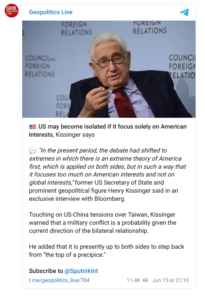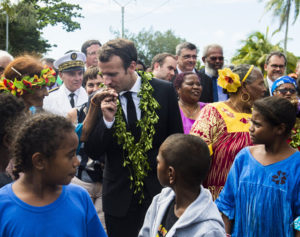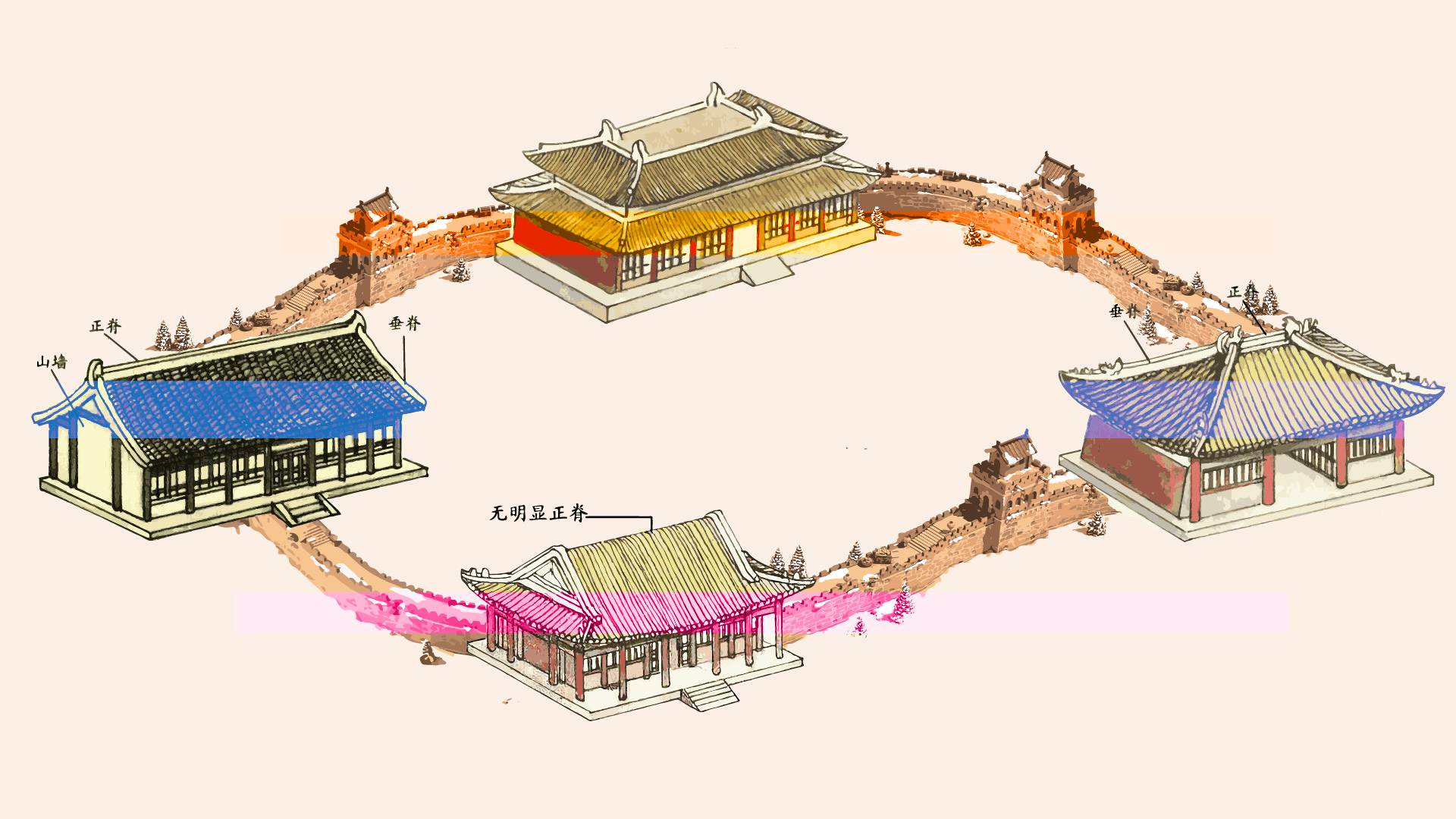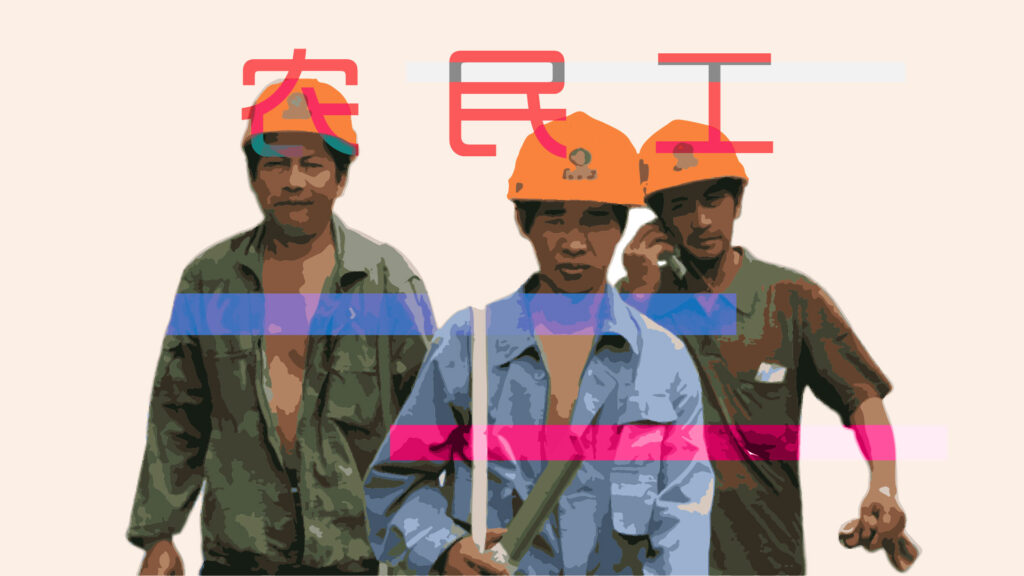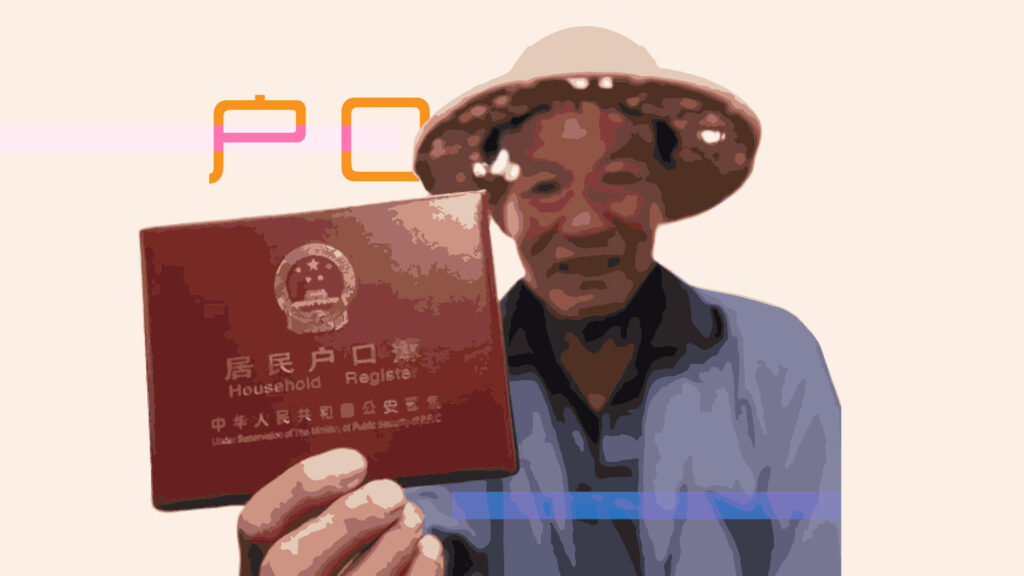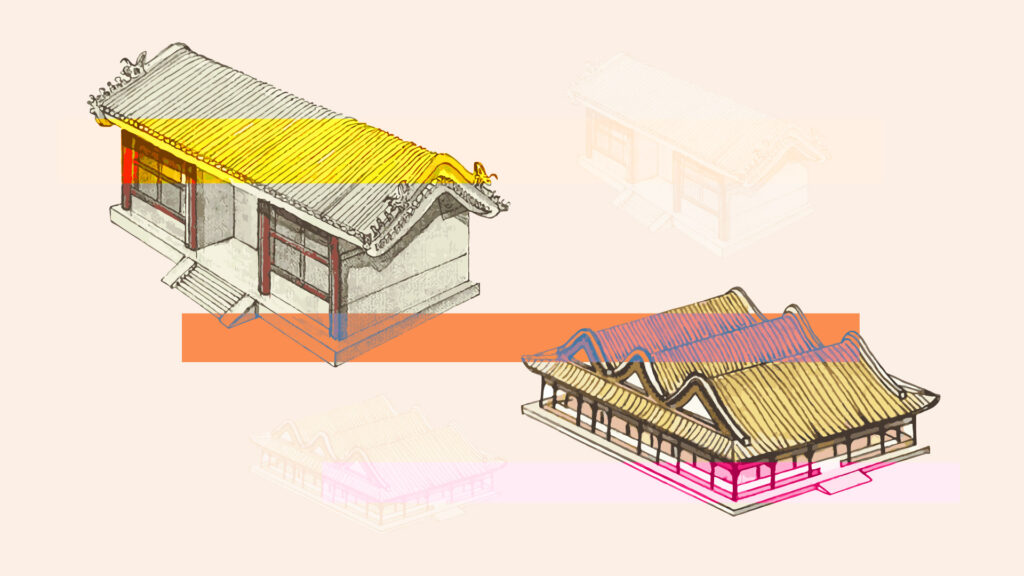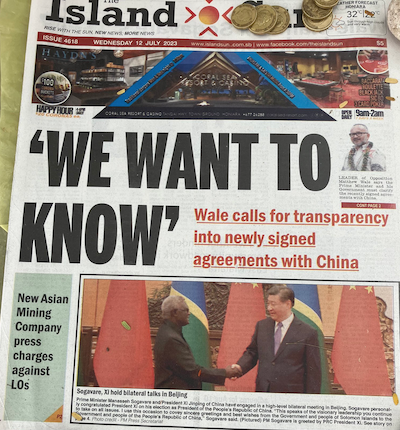
Orientation
How long has capitalism existed? Has it always been with us all the way back to tribal societies or is it a product of the modern age? Is there any pattern to its evolution? Is it cyclic, spiral-like or random? What is the nature of capitalist crises? Why does capitalism grow flush in certain parts of the world, die out in others and yet seemingly reignite itself in another part of the world? What can world-systems theory tell us about the current battle between the Anglo-American empire and the multipolarists of China, Russia and Iran?
What is capitalism?
Capitalism is a historical economic system that arose in Europe in the 15th century. Over a 600-year period its leading hegemons were first the Italian city-states of Genoa and Venice. In the 17th century these city-states were superseded by the Netherlands. The British overtook the Dutch in the 18th century and the United States crowded out the British well before World War I. Capitalism is characterized by a law-enforced right of private property (as opposed to state or community ownership) in the areas of:
- raw materials (land)
- means of production (tools and methods of harnessing energy)
- labor (who uses the tools and the methods of harnessing energy to work on raw materials)
- commodities (finished products and services)
- money which is transformed into capital – stocks, bonds and derivatives
- power settings in which decisions about the economy are made (political settings). These include The National Association of Manufacturers and The Business Round Table. Internationally the Council of Foreign Relations, the World Economic Forum and the G7 are examples.
The purpose of capitalism is to make a profit which is unlimited in scope, protected by law, and if necessary, by the military. According to world-systems theorist Immanuel Wallerstein capitalists derive their profits by two processes:
- broadening its reach, colonizing the periphery counties for its natural resources, inducing it to produce a single cash crop while paying wages far below wages of the workers in the core countries.
- deepening its reach into core countries through increased commodification of previously uncommodified land and labor, automation, withdrawal of investment in military and finance capital
Trends in capitalism
Trends within capitalism over a 600-year period include:
- a tendency towards a concentration of capital
- a tendency to expand around the globe through transnational corporations
- a movement from scattered territories to larger territorial control
- phases in investing in merchant, agricultural (slavery), industrial, military and finance capital which become cycles
- these become Kondratieff waves of expansion and contraction which occur every 55 years.
- the end of a cycle is characterized by bifurcation points, crisis which occur at shorter and shorter intervals
- crises points fuel increasing anti-systemic opposition
- capitalist crises which accumulate to produce both the possibility of abundance, shorter work week and an accumulation of crisis of unresolved problems of previous cycles including ecological devastation
- greater variety of resources
Where are we headed?
I begin my article by comparing world-systems theory to modernization theory across seven categories. Next, I compare the characteristics of the three zones in world-systems theory – core, periphery and semi-periphery. While we can imagine capitalism over a 600-year period as a movie, we also want to take “snapshots” of the world-system on four separate occasions. Probably the most important part of the article is in describing Giovanni Arrighi’s cycles and spirals of capitalism over the last 600 years up to the close of the 20th century. In the last section in the piece I identify all the revolutionary changes that are happening to the 21st century world-system. The battle between the Anglo-American empire and the multipolarists will be framed from a world-systems perspective.
What is World-systems Theory?
In the 1950s, political science and international relations was dominated by an anti-communist “modernization theory”. In the 1960s the conservativism of modernization theory was first challenged by something called “dependency theory” led by Andre Gunder Frank and later by the “world-systems theory” of Immanuel Wallerstein. World-system theories were socialist but they were critical of the state socialism of Russia, China and Cuba. They argued that those countries were state capitalist. They strove to apply Marx’s theory of capitalism to the whole world as opposed to just single nation states as many Marx did. They challenged Lenin’s theory of imperialism as the last stage of capitalism as being too linear. In their perspective, imperialism is part of the end of each of the four cycles and was common for the Italians, the Dutch, the English and now the Yankees.
World-systems theory was criticized by more traditional Marxists like Robert Brenner because he felt they did not emphasize enough the class struggle within nation states. World-systems theory seemed to be more interested in the political economy of the dynamics of three zones (core countries, peripheral countries and the semi-peripheral countries) rather than the class struggle within each zone. I’ll discuss these zones in detail shortly.
Modernization Theory vs World-systems theory
Are nation-states primarily independent or interdependent?
For modernization theory, nation states are independent and internally driven. The responsibility for their past, present and future direction is strictly determined by their foreign policy. In world-systems theory, nation-states are subordinate to an international system of capitalism and have only relative control over their foreign policy.
Therefore, modernization theorists would look at poor countries in the world (what world-systems theory might call the periphery) and say their poverty was due to a failure to build modern institutions such as science or capitalism. They are dismissed as irrational tribalists marred by superstition. World-systems theorists would say countries on the world periphery are poor because they have been colonized and exploited by the core countries. Because nation-states are understood to be autonomous, capitalists are thought to be loyal patriotic servants of their nation-states. For world-systems theorists, capitalists are the most unpatriotic class of all. They are committed to making profits anywhere in the world. They will feign patriotism when they need foot soldiers to fight wars against other capitalist countries but otherwise they have no loyalties.
What is the relationship between politics and economics?
For modernization theorists’, politics and economics are separate. As you can well see, throughout the 1950s and even after modernization theory was criticized in the 1960s in political science classes, economics was never a serious part of a discussion. It would be like saying political meetings in Congress are strictly determined by the political ideologies of liberalism or conservatism. Money has no part in it. At the same time, the teachers of economics courses act like capitalist economics has no political dimension. This would be like saying the economic decisions of transnational corporations would not be influenced by political turmoil or a revolution in a periphery country in which they had large investments. Speaking internationally, for modernization theory, all wars are about political ideology.
For world-systems theorists, there is only political economy. All economics is political and all political acts have economic aspects to it. For world-systems theory, wars have mostly to do with battles over natural resources. They also can be political but when a socialist country gains power in a war the trade relations become more unfavorable for capitalists.
How is social evolution understood?
Modernization theories imagine social evolution as progress. They say there is something inherently progressive about Western societies that older civilizations such as China and India lack. The wealth produced by capitalist societies is distributed somewhat unevenly because some people work harder than others. All roads in social evolution lead to the West with the pinnacle being Western Europe and the United States. Progress is linear, and modernization theory imagines that tribal societies are just dying to be modernized, blaming themselves for their situation. Modernization theory fails to account for complex societies’ disintegration and going backward (Tainter, The Collapse of Complex Societies) or Jared Diamond (Why Societies Collapse). Even when socialist societies are industrialized they are not considered modern because state control over the economy and one-party rule lack democracy.
World-systems theory argue that progress in the history of human society has been uneven. They are willing to admit that the egalitarian nature of hunter-gatherers is admirable. They are well aware that an increase in the productive forces through technology, in fact, leads to more work for the lower classes rather than less. While world-systems theory acknowledges the benefits of science and some of the wealth produced by capitalism, it also points out the exploitation and misery it produces for working-class people as a result of class stratification.
Rate and type of change
Generally speaking, modernization theory understands the rate of social change to be gradual, evolutionary and relatively harmonious across social classes. For world-systems theory, like all Marxist theories, political and economic change is sudden, discontinuous, filled with conflict and driven by class struggle. For modernization theory instabilities are temporary and part of “business cycles” which settle back down into equilibrium and homeostasis. For world system theory, capitalist crisis is no static equilibrium model. Capitalism today will turn into a terminal crisis from which it will not recover. Whether it is the tendency of the rate or profit to fall, profit squeeze theory or under-consumption theory, the days of capitalism are numbered.
While for modernization theory all roads start and end in Western Europe and the United States, for world-systems theorists, modernization may have begun in Europe, but it by no means is it likely to stay there. As we can see today, the world-system is shifting operations to China, the new center of the world-economy.
Attitudes towards socialism
As I mentioned before, modernization theorists are anti-communist. The only socialism for modernization theorists is Stalinism. Even when socialist societies industrialize, modernization theorists deny they are a modern system, because they lack bourgeois rights and a two-party system. They see socialist societies as some kind of throwback to Karl Wittfogel’s Orientation Despotism. While world-systems theorists essentially call themselves socialist, they criticize Stalinism as state capitalist, and Cuba and China as bureaucratic states. They look more favorably to Nordic evolutionary socialism, especially Sweden in the 20th century up to around 1980.
Modernization theory understands capitalism and socialism as two separate systems. It imagines the rebellions of the 1960s as rebellions against socialist regimentation. It has been difficult for them to explain why an entire generation would rebel against the fleshpots of capitalist modernization in Western Europe and the United States. On the other hand, world-systems theorists understand that the existing socialist countries, including the state socialist countries, are part of a broad anti-systemic movement against capitalism which includes the various Leninist parties, social democrats and anarchists.
For modernization theorists’ socialism has been tried and failed. Case closed. They would support Fukuyama’s claim that after the fall of the Soviet Union, history is over and capitalism has won. “Not so fast” say world-systems theorists. Capitalism is 500 years old and has only achieved economic and political dominance in the 19th century. Socialism is about 170 years old. It is too soon to tell whether socialism is a realistic alternative.
Place and misplace of foreign aid
For modernization theorists aid to poor or peripheral countries may be driven by a combination of self-interest at worst, and at best creating win-win situations. Foreign aid is given in the hopes that with the help of the West poor countries will industrialize, shed their backward ways and become competitive partners. For world- systems theorists the relation between core and peripheral countries is not neutral but imperialistic. Rich countries exploit poor countries for their land and labor and turn them into one crop-producing colonies. As Andre Gunder Frank quipped, the core countries underdeveloped the peripheral countries. Furthermore, world capitalist banks like the World Bank or the IMF do not give loans that will enable peripheral countries to build scientific institutions along with engineers. One reason is because scientists and engineers may discover new resources that might undermine the resources of core countries such as oil. This is one reason why fundamentalist religious institutions always seem to grow in peripheral countries because they are of no threat to capitalism. The CIA always finds money for them.
Theoreticians
As I’ve said, modernization theorists were most prevalent in the 1950s. They included Walt Rostow and Lucian Pye. Daniel Lerner specialized in telling the story of how tribal societies got on the road to modernization. Samuel Huntington is more contemporary with works like The Clash of Civilizations along with Francis Fukuyama, with his book The End of History.
Early world-systems theorists were Oliver Cox who looked at race and caste from an international perspective. Immanuel Wallerstein provided a foundation for world-systems theories, drawing on the work of Fernand Braudel. Christopher Chase-Dunn and Tom Hall extended a world-systems perspective all the way back to tribal societies. Giovanni Arrighi took a deep look at the history of capitalism (to be covered shortly) and Samir Amin has been a kind of watchdog always trying to keep world-systems theory from being too Eurocentric. Beverly Silver made a study of workers movements from a world-systems perspective. Lastly Christopher Chase Dunn and Terry Boswell located the history of workers’ movements over a 600-year period of capitalism, not as isolated in nation-states (as traditional Marxists have done) but as part of the dark side of the cycles and spirals of capitalism.
Characteristics of the Three Zones
In world-systems theory, there are three regions of the world — the core, the periphery and the semi periphery. In the 20th century the core countries were the wealthy countries of Yankeedom, Western Europe and Japan. The Scandinavian countries are cases of successful state-capitalism. Most of the periphery countries were the heavily colonialized states of Africa. In the semi-periphery were Russia, China, Eastern Europe, most of Latin America and Southeast Asia.
Economics and politics
Contrary to what Marx predicted, there are no countries in the core of the world- system that are socialist. In the semi-periphery there has arisen both capitalist and state socialist societies. Most of the periphery countries are operating with a combination of tribal or state redistributive system combined with exploited low wage workers at the beck-and-call of imperialists in the core. In terms of political power, core countries have developed their own bourgeois representative systems without any political pressure outside the core. Peripheral countries have the least political power. Many of the core countries have installed dictatorships there in the hopes of controlling peripheral economies. Home-grown leaders of peripheral countries are often anti-imperialist revolutionaries agitating to overthrow imperialism in their country.
Countries in the semi-periphery have a moderate degree of autonomous political power but their elections are closely watched by the deep state in core societies because they have more technological self-rule and could get out of control. In state socialist countries, political power is highly concentrated at the top. Socialist societies cannot afford to have many political parties. Those smaller parties are subject to manipulation by the deep state within core countries which works to overthrow socialism. Because peripheral countries have been exploited by imperialism they are poor. World capitalist banks offer loans at interest rates so high that it is rare for peripheral countries to get out of debt. The loans received from these banks are only for raw materials and for cash crop agriculture. No loans are made for education or building infrastructures.
Energy bases, commodities and wages
The energy bases of core countries are electronic-industrial. The semi-periphery countries are industrial-agricultural while in the periphery they are mostly agricultural or horticulture in the sub-Sahara Africa. The technology in the core countries draws on inanimate sources of energy and machine-based. In the periphery, work is labor intensive using mostly animal and wind power. In the semi-periphery capitalists implement hand-me-down machines from core countries. As might be expected, wages are highest in core countries because unions have been institutionalized. In the periphery, because there is very little industry, there are no unions and it is here where wages are lowest. Typically, workers might work part-time in industry, also working in garment industry, as water carriers, day laborers with some cash crop planting. In the semi-periphery there is some unionization and in state-socialist societies wages might be good.
Commodities and economic policy: free trade vs protective tariffs
Because of their colonial relations with the periphery core counties import raw materials cheaply and export manufactured goods, which are more expensive. In peripheral countries, they export raw materials, mostly cash crops and import goods from the West at higher prices, keeping them in a dependent relationship.
The economic policy of the core countries is “free trade” which, of course, is not free but gives them a license to go wherever they want, exploiting land and labor where there is little or no resistance. Countries in the semi-periphery, when driven by their population or the vision of their leaders, may adopt protective tariffs in the hopes of protecting the growth of their home industries. On the periphery, the economic policy is forced free trade with colonialists. Often one of the major efforts in peripheral liberation movements is to elect leaders who follow protective tariffs to attempt to build up home industries. Semi-periphery countries are somewhat dependent on core countries but they in turn also exploit the periphery to a less extent. These semi-periphery countries use their surplus to invest more in their domestic economy. They export peripheral-like goods to the core and export core goods to the periphery.
Class, race, ethnic and regional conflicts
For most of the 20th century in the core countries the conflicts between groups were class conflicts and in the United States, race conflicts. However, regional conflicts still smolder in Yankeedom between North and South. In Europe regional loyalties smolder in Spain, Northern Ireland, Belgium among others. The semi-periphery has similar class and regional problems. The periphery is torn apart between tribal loyalties and loyalties to the newly formed states which were once part of national liberation movements.
Role of the military
Lastly, we turn to the role of the military. After two world wars over colonies, core states have agreed not to attack each other and the military is rarely involved in its domestic politics. The military of core countries is mostly employed in attempting to control the political life in the semi-periphery and the periphery. The military in semi-periphery countries is more volatile because core countries are concerned about the domestic policies there since these countries have the resource base – the science and engineers – to undermine the resource base of the core. The military in the semi-periphery gets involved, either as right-wing dictators or to bring in a left-wing military leader such as Hugo Chavez. The most direct military involvement is in the periphery because colonialists want to maintain control of the cheap land and labor they exploit. The military also tries to impose order in clashes within the domestic population between tribes, ethnic groups and state loyalists.
Snapshots of the History of the World-system
In his book An Introduction to the World-system perspective, Thomas Shannon introduces four “snapshots” (maps) of the world-system:
- world-system from 1450-1620 (merchant capital)
- world-system in 1763 (agricultural, slave capitalism)
- world-system in 1900 (industrialization)
- the contemporary world system in 20th century (finance capital, electronics)
What might be confusing is that the world-system, though it has the “world’ in it, does not mean it is a global society. For most of the history of world-system, the core, periphery and semi periphery only covered part of the globe. The fact is in the world system of 1450-1620 most of the world system was concentrated in Europe – Spain, Portugal, the Netherlands, France and England. The periphery consisted of the Scandinavian countries and central and South America. The United States was not even in the world-system while Russia, China and India were part of agricultural empires.
In the 1763 snapshot, the core countries are Great Britain and France, with the Netherlands, Spain and Portugal slipping into minor core status. The semi-periphery then consisted of the North Italian city-states and Prussia. Thanks to colonialization by the British, the United States and West Africa were now on the periphery of the world system. Poland and Russia were now in the periphery. China and India were still outside the world system.
By 1900 Great Britain and France remained as core countries but they were now joined by late developing Germany and the United States. By 1900 most of the globe was now in the world-system, with Russia moving to the semi-periphery and China now on the periphery. This was the age of colonialism as all of Africa, China and South America were on the world capitalist periphery.
By the 20th century the world-system was rocked by two world wars which hollowed out Europe and reduced them to minor core status. The rise of Japan in the late 19th century and early 20th century catapulted it into core status. The first three quarters of the 20th century were the time of Yankeedom. The 20th century saw the emergence of the first socialist states in Russia, China and Cuba. Russia maintained its semi-peripheral status while Cuba and China continued to be poor and in the periphery of the world-system.
Capitalist Cycles and Their Leading Hegemons
In 1994 Giovanni Arrighi wrote a great book with a bad title, The Long 20th Century.
The heart of the book is the tracing of the history of capitalism through four cycles. Instead of looking at capitalism as a linear line moving from merchant capitalism to agricultural capitalism, to industrial, to finance capitalism and imperialism, Arrighi analyzed capitalism as a series of four cycles which played themselves out through leading hegemons throughout Europe. Through each cycle there were mercantile, agricultural, industrial and financial phases, but they weren’t all of the same weight.
Italian city-states
For example, the first place the cycles occurred were in the city-states of Genoa and Venice between 1450 and 1640. They made profits based on merchant capital through trading. Being city states, they didn’t make much profit on agriculture and what industry existed was small. However, when their profits were made on finance and wars, that was the end of their power. As we shall see throughout all hegemon rulers, when profits are made on war and finance they are on their way out.
Dutch sea trade
After the Italian wars and the discovery of new trade routes West, the Italian city-states lost their core status. Dutch sea power arose in the 17th century. Again, the Dutch profits were based on merchant trade but trade on a much larger scale than the Italians. They were led by East Indian and West Indian monopoly companies. There were at least five reasons the Dutch superseded Genoa and Venice.
- scale of operation – the Dutch had greater commercial and financial networks
- financial base of the Dutch monopoly companies are less vulnerable to competing trade countries
- Dutch interest clashed more dramatically with central authorities of medieval world. This drove them to be more independent from religion
- Dutch war-making was superior
- the Dutch had greater state-making capacity
The end of the line for the Dutch was also when money houses became a greater source of profit than trade. Dutch hegemony ended in wars with the English beginning in 1781. England was also a great sea power at this time and were also better colonizers than the Dutch.
The sun never sets on the British empire
The secret to British hegemony in the 19th century was the industrial revolution. Here profits were made rebuilding cities with railroads and textile factories. While Britain made profits on trade (merchant capital), while it derived profits from cash crops and slavery (agricultural capital), what made it distinct was the industrial revolution and the harnessing of coal and steam. For Britain the end came towards the end of the 19th century when it shifted its wealth from industry to finance, The British empire was with the wars over colonies with Germany, Italy and Japan.
The American century 1870-1970
The United States made profits off its sea power and its planters made profits on agricultural slavery working with the British. But its greatest profits derived from industry. By the second half of the 19th century the United States became an industrial powerhouse, competing directly with the British. Besides coal, the oil Barons made a fortune on the railroads in this ascendent phase of capitalism. In the two world wars that followed, the United States became the only core country standing. After World War II it was the sole core power. Between 1948-1970 it peaked.
However, in the 19th and 20th centuries capitalist countries were racked by depressions in 1837, 1873 and 1896 and then the Great Depression of 1929-1939. Capitalists in the United States noticed that it was investment in military arms that got the US capitalist economy out of the depression more than Roosevelt’s programs. After World War II, the defense industry became an ongoing investment even in peace-time. Then it began to sell arms around the world to fight communism.
Lastly, investing in finance capital – stocks, bonds and derivatives – gave quicker turn-around profits than investing in industry. Once Japan and Germany had recovered from World War II, the United States faced real competition. Instead of investing in infrastructures, it invested in finance capital. Instead of investing in its workers, it pulled industries out of the United States and relocated in peripheral countries where land and labor were cheap. This was the beginning of the end. So began a 50-year decline.
Trends in the History of Capitalism
From investing in the physical economy to investment in finance
In describing these trends as a whole, Arrighi takes some liberties with Marx’s C-M-C; M-C-M formula. He says that in the ascendant phase of capitalism the M-C moment of capitalism is pronounced. That means that money is invested in commodities, trade, production and expansion. Money is invested in solid material. When a hegemon’s days are numbered C-M commodities are invested in money, the capitalist economy is contracting and capital is invested in finance capital, profits made on stocks and bonds can easily be moved around (liquidity).
Shortening of cycles
The four cycles Arrighi analyzes are not evenly distributed in time across the hegemons. The pace of rise and fall speeds up. The rise and fall of the Italian city-states was 220 years; the United Dutch provinces lasted 180 years; the British heyday lasted 130 years and the United States 100 years from 1873-1973. Meanwhile the cycles do not just end and resume again without accumulating consequences.
Some twentieth century trends
- artificial intelligence which has the potential to shorten the work week
- the opportunity to live longer – thanks to science
- the chance to colonize space
- an increase in rebellion over the centuries including the rise of socialism in the second half of the 19th century among workers and peasants
- the impact of ecology with increasing pollution and severe weather
- the deterioration of health due to genetically modified foods and pharmaceutical drugs.
Revolution in the World-system in the 21st Century
Rise of an alliance between semi-periphery countries
When the Soviet Union collapsed around 1990 it looked as if, despite its declining power, Yankeedom would continue to be the hegemon into the 21st century. But a funny thing happened in the first two decades of the 20th century. One was the rise of nationalism in Russia under Putin. The other was the emergence of a powerhouse economy in China. This was predicted by Arrighi in his later book Adam Smith in Beijing and Andre Gunder Frank’s book ReORIENT.
From a world-systems perspective, the rise of a semi-peripheral country like China is no surprise, as world-systems theory has always argued that the semi-periphery countries have the most revolutionary potential. This is because they are wealthy enough to support scientists and engineers who potentially can produce an economic policy separate from the core countries. What seems unprecedented is the alliance of two semi-peripheral countries (Russia and China) with a deep alliance which cuts across military and economic cooperation.
In fact, the rise of BRICS as a challenge to the World Bank and the International Monetary Fund is noteworthy because virtually every country in BRICS is a semi-peripheral country. The multipolar world is composed of semi-peripheral countries unified by the New Silk Road. Furthermore, if China continues to grow the way it has been, in the next twenty years it will become the first core country since the beginnings of capitalism not located in the West. Secondly, under the leadership of the Communist Party and state-owned enterprises, China clearly has a socialist end in mind. It would be the first time a core country in the world-system was socialist. Third, China has not pressured Russia, Iran or any country in the multipolar orbit to become socialist. So whatever political and economic tensions might develop in the multipolar world, it is not likely to be the old capitalism vs socialism battle.
The United States and Europe
In the new multipolar world-system, the United States will sink to the status of a semi-peripheral country because its capitalists will not invest in rebuilding its abandoned infrastructure. It is likely to live on as a home of finance capitalists giving loans to other decimated capitalists countries or in supplying military arms to countries which have not joined in the multipolar world. These lost countries could be in South or Central America or in Middle Eastern countries which are not part of the Belt Road initiative.
Europe has been vassal of the United States for 80 years. Up until the last couple of years, Germany was the only European country which was an industrial powerhouse. But this has changed since the US has insisted that Europe abide by its sanctions of Russia. There is not a single European county with the exception of Hungary that has stood up to the United States. As the United States continues its decent from core to semi-periphery, Europe will follow with England being the weakest country. Once it slowly dawns on the European rulers that Yankeedom will not save them, they may attempt to make back-room deals with Russia and China in terms of natural gas and other sources of energy. It might be that in the next 50 years the old European core countries may regain their balance and occupy a semi-peripheral status in the new multipolar system.
The Middle East and South America
To the extent that China can diplomatically integrate Saudi Arabia and Iran and the Middle Eastern countries with oil, they will remain in the semi-periphery of the world’s new multipolar system. Expect Israel to degenerate as Mordor will be less able to help them and they will be surrounded by hostile Arab states with scores to settle. In South America Argentina and Chile will join Brazil in the semi-periphery. Venezuela will finally be spared from Mordor’s intervention and be protected by China as a fellow socialist society.
Global South
The refusal of African states to do the bidding of Mordor against Russia speaks volumes for the end of their hopes to ever get a fair deal from the United States or its financial institutions. There has been an openness to project proposals from China and Russia for building railroads and schools. Some African states like Nigeria or Sudan might, over the course of a generation, build their countries up to a semi-periphery status the way Libya was when Gaddafi was in power.
This post was originally published on Dissident Voice.


